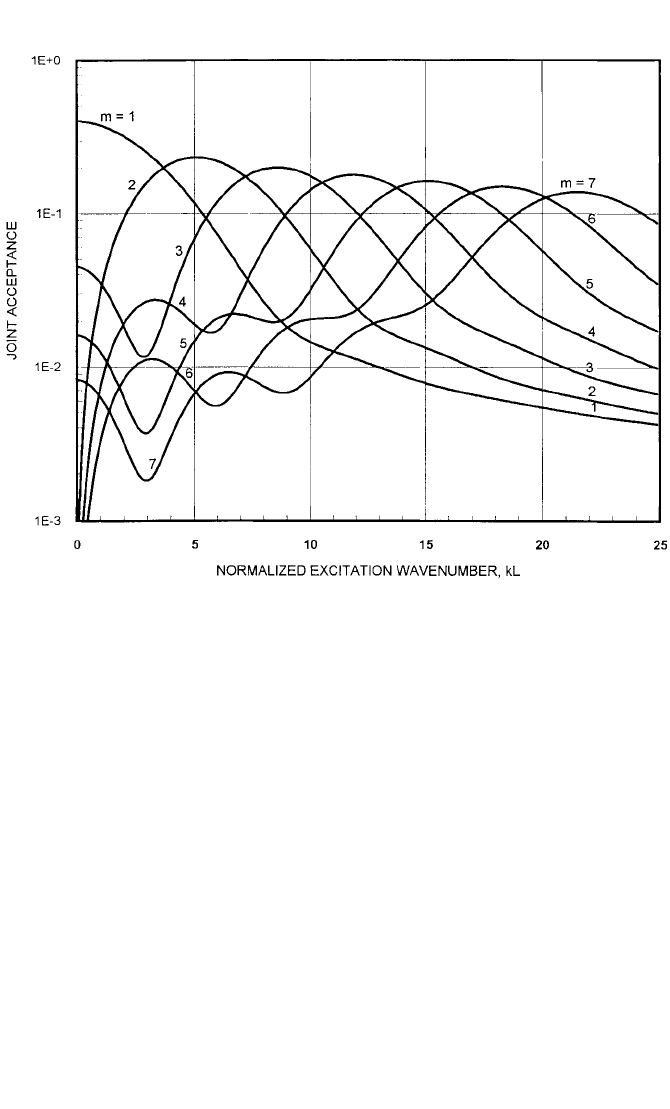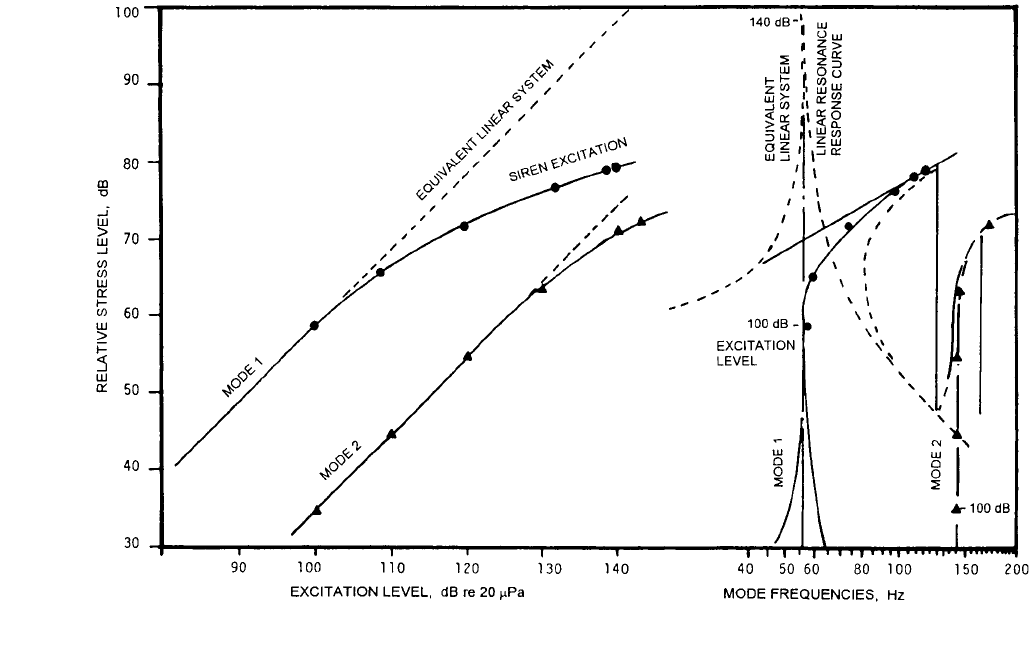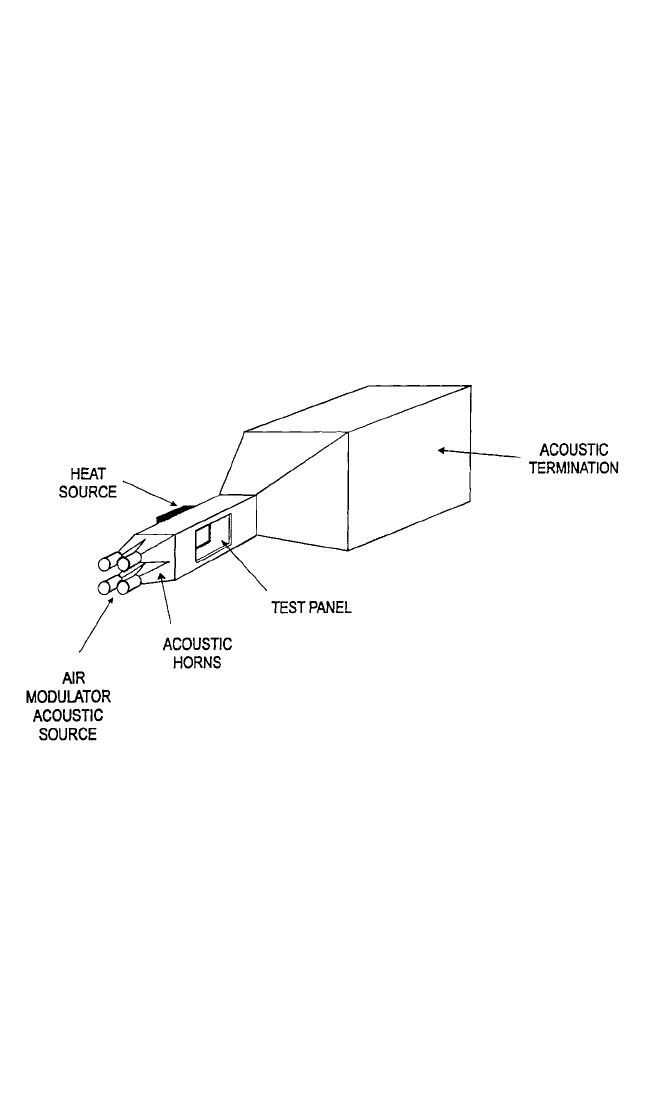Harris C.M., Piersol A.G. Harris Shock and vibration handbook
Подождите немного. Документ загружается.


γ(ξ,ω) = exp
−
2
+
2
0.5
|ξ|
cos
(29.64)
have been proposed for attached turbulent boundary layers. There is little corre-
sponding information for separated boundary layers, where the flow is much more
complicated.
IMPULSIVE SOUNDS
Impulsive sounds, such as sonic booms generated by airplanes in supersonic flight
1
and blast waves from explosions, can cause transient vibration of a structure.
ANALYTICAL METHODS
It is often assumed in the analysis of structural response to acoustic excitation that
the structure responds in a linear manner, so that there is a linear relationship
between excitation force and structural response. However, this assumption may not
be valid when the acoustic excitation levels are high. In that case the response is non-
linear.
LINEAR ANALYSIS
Several different methods can be used to calculate the linear response of a structure
to acoustical excitation. They include classical normal mode analysis, statistical
energy analysis, and finite element analysis. Each method has its own advantages
and disadvantages.
Classical Normal Mode Analysis. In the classical modal formulation,
9
the acceler-
ation autospectrum G
a
(x,ω) for location x and angular frequency ω can be written as
G
a
(x,ω) =ω
4
A
2
G
p
(ω)
r
s
ψ
r
(x)ψ
s
(x)H
r
(ω)H
s
*(ω)j
2
rs
(ω) (29.65)
where A is the area of the structure exposed to the excitation, G
p
(ω) is the excitation
pressure spectrum, ψ
r
(x) is the mode shape of mode of order r, H
r
(ω) is the structural
mode response function, j
2
rs
(ω) is the cross acceptance that describes the spatial cou-
pling between the excitation pressure field and the structural mode shapes, and an
asterisk denotes a complex conjugate. The cross acceptance is defined by
j
2
rs
(ω) = G
p
(x, x′,ω)ψ
r
(x)ψ
s
(x
′
)dxdx′ (29.66)
and the structural mode response function is defined by
|H
r
(ω)|
2
= M
r
−
2
[(ω
r
2
−ω
2
)
2
+η
r
2
ω
r
4
]
−1
(29.67)
where η
r
is the damping loss factor (η
r
= 2ζ
r
, where ζ
r
is the damping ratio), M
r
is the
modal mass, and ω
r
is the resonance frequency of mode r. The modal mass is defined
as
1
A
2
G
p
(ω)
ωξ
V
c
0.27
δ
0.1ω
V
c
29.56 CHAPTER TWENTY-NINE, PART III
8434_Harris_29_b.qxd 09/20/2001 11:44 AM Page 29.56

M
r
=
A
mψ
r
2
(x)dx (29.68)
where m is the mass per unit area for a panel of area A. For a uniform panel with
simply supported boundaries, M
r
= mA/4. Prediction methods for ω
r
can be found in
Chap. 7.
If the damping is small and the fluid loading is negligible (which is usually true in
air but not in water), the vibration is dominated by the response at the resonance
frequencies and contributions from the cross terms (r ≠ s) can be neglected. Then
Eq. (29.65) becomes
G
a
(x,ω) =ω
4
A
2
G
p
(ω)
r
ψ
r
2
(x)|H
r
(ω)|
2
j
r
2
(ω) (29.69)
In Eq. (29.69), the cross acceptance of Eq. (29.66) is replaced by the joint acceptance
j
r
2
(ω) = G
p
(x, x′,ω)ψ
r
(x)ψ
r
(x
′
)dxdx′ (29.70)
Assuming that the structure has simply supported boundaries, and G
p
(ω) and j
r
2
(ω)
vary slowly with ω in frequency band ∆ω, the space-average, mean square response
in frequency band ∆ω is
[a
2
]
∆ω
≈ G
p
(ω)
r
j
r
2
(ω)
∆ω
|H
r
(ω)|
2
dω (29.71)
For small damping
ω
|H
r
(ω)|
2
dω≈ (29.72)
and Eq. (29.71) reduces to
[a
2
]
∆ω
≈ G
p
(ω)
r ∆ω
(29.73)
The notation r ∆ω signifies that the summation is over all modes of order r whose
resonance frequency ω
r
lies in the frequency band ∆ω. From Eq. (29.73), the accel-
eration spectral density, averaged in space and frequency, is
〈G
a
(ω)〉
A,∆ω
=≈ G
p
(ω)
r ∆ω
(29.74)
where 〈〉
A,∆ω
denotes averaging over area A and frequency band ∆ω. It can be seen
in Eqs. (29.69), (29.73), and (29.74) that the two functions representing the excitation
pressure field are the pressure autospectrum, G
p
(ω), and the joint acceptance, j
r
2
(ω).
The classical normal mode approach of Eq. (29.69) is an accurate way to predict
structural response to acoustic or aeroacoustic pressure fields, provided that the rel-
evant details of the structure and pressure field are known and represented cor-
rectly. However, that is often not the case. It is difficult to obtain the cross-spectrum
data for the pressure field and approximations have to be made. Also, an accurate
description of the normal modes and resonance frequencies of the structure is not
always available, especially for complicated structures. Experimental procedures
(see Chap. 21) and analytical methods, such as finite element analysis (see Chap. 28,
Part II), might be used to obtain normal mode information, but both methods
j
r
2
(ω)
ω
r
3
M
r
2
η
r
ω
4
A
2
π
8∆ω
[a
2
]
∆ω
∆ω
j
r
2
(ω)
ω
r
3
M
r
2
η
r
ω
4
A
2
π
8
π
2ω
r
3
η
r
M
r
2
ω
4
A
2
4
1
A
2
G
p
(ω)
VIBRATION OF STRUCTURES INDUCED BY SOUND 29.57
8434_Harris_29_b.qxd 09/20/2001 11:44 AM Page 29.57

become increasingly inaccurate as frequency increases. One solution is to resort to
averaging techniques such as Eq. (29.73) or (29.74), but that has the disadvantage of
eliminating some of the details in the results. Statistical energy analysis (see Chap.
11) is a further step in the averaging process.
Analysis of structural response to sound underwater is complicated by the fact
that fluid loading is no longer negligible and has to be included in the analytical
model.
21,22
The effect of fluid loading depends on whether the frequency of interest
is below or above the critical frequency, which is defined as the frequency at which
the trace wavespeed of the sound field is equal to the wavespeed of the flexural or
bending waves in the structure. At frequencies below the critical frequency, fluid
loading essentially acts as an entrained mass that has to be included as a second mass
term in the equations of motion.
22
At frequencies above the critical frequency, the
fluid loading influences the radiation resistance and the sound radiation into the
fluid.
22
Joint Acceptance. The joint acceptance function describes the efficiency by
which a particular pressure field can excite a structure. For a given pressure spec-
trum G
p
(ω), different types of excitation, with different joint acceptance functions,
will generate different vibration levels in the responding structure. For example, tur-
bulent boundary layer pressure fluctuations will produce different vibration levels
than will jet noise of the same pressure level.
Simplifying assumptions are usually introduced so that the joint acceptance can
be obtained in closed form. Specifically, it is commonly assumed that the pressure
field is homogeneous, so that x
and x
′
can be replaced by ξ, where x
′
− x =ξ. The vec-
tor ξ has components ξ
x
and ξ
y
in the x and y directions, respectively. Also, it is
assumed that the joint acceptance is separable in the x and y directions. Finally, it is
assumed that the structure is simply supported at the boundaries. Then, the compo-
nent of the joint acceptance in the x-direction is
j
2
m
(ω) =
L
x
γ
x
(ξ
x
,ω) cos (k
x
ξ
x
) sin
sin
dxdx′ (29.75)
with
γ
x
(ξ
x
,ω) = (29.76)
and mode order r (m,n). Similar relationships apply in the y-direction.
Closed-form joint acceptance functions for three different types of excitation,
namely, attached turbulent boundary layer, jet noise, and diffuse (reverberant)
sound field, are given in Ref. 20. Typical nondimensional joint acceptance curves
based on Eqs. (29.75), (29.76), and (29.59) are shown in Fig. 29.38, for the case where
the decay parameter a in Eq. (29.59) has a value of 0.1. The joint acceptance for the
first mode shape (n = 1) has a maximum value at zero wave number or frequency,
but the joint acceptance for each of the other modes has a maximum value at a
nonzero value of frequency. Those maxima for the higher-order modes occur when
the wave number of the excitation is equal to the flexural wave number for the struc-
tural mode, a condition known as coincidence.
Statistical Energy Analysis. Statistical energy analysis (SEA) makes the general
assumption that it is not practical to represent all the details of a structure in a given
response prediction procedure (see Chap. 11). Thus, ensemble averaging is per-
|G
p
(ξ
x
,0,ω)|
G
p
(ω)
mπx′
L
x
mπx
L
x
1
A
2
29.58 CHAPTER TWENTY-NINE, PART III
8434_Harris_29_b.qxd 09/20/2001 11:44 AM Page 29.58

formed over a series of similar, but slightly different, structures to obtain an average
response. In practice, ensemble averaging is time-consuming, so it is replaced by fre-
quency averaging.
Equation (29.74) leads to a typical SEA relationship for simply supported panels,
specifically,
〈G
a
(ω)〉
A,∆ω
= G
p
(ω) (29.77)
where 〈〉
∆ω
denotes averaging over frequency, n
r
(ω) is the modal density of the struc-
ture, and m is the mass/unit area of the panel (assumed uniform). The frequency-
band-averaged joint acceptance is
〈j
r
2
(ω)〉
∆ω
=
N
r = 1
j
r
2
(ω) (29.78)
where N is the number of modes with resonance frequencies in frequency band ∆ω.
The modal density of the structure is defined by
n
r
(ω) = (29.79)
For a flat panel,
dN
dω
1
N
〈j
r
2
(ω)〉
∆ω
〈η
r
〉
∆ω
2πωn
r
(ω)
m
2
VIBRATION OF STRUCTURES INDUCED BY SOUND 29.59
FIGURE 29.38 Joint acceptance curves based on Eqs. (29.75), (29.76), and (29.59), with decay
parameter a = 0.1. L = length of panel, m = mode order, k = excitation wave number [Eq. (29.60)].
8434_Harris_29_b.qxd 09/20/2001 11:44 AM Page 29.59

n(ω) = (29.80)
where h is the panel thickness and c
L
is the longitudinal wave speed in the structure
given by
c
L
=
(29.81)
In Eq. (29.81), E is Young’s modulus of the structural material, ρ is the material den-
sity, and v is Poisson’s ratio.
The use of SEA techniques to simplify the analysis has the advantage that the
response can be calculated to high frequencies with minimum computing time, but
there is the disadvantage that the use of space- and frequency-averaging methods
means that structural response cannot be predicted for a specific point on the struc-
ture nor at a specific frequency. Additional methods have to be used to supplement
the SEA calculations. Further discussion on statistical energy analysis can be found
in Chap. 11.
SEA is of limited value at low frequencies where modes are sparse (N < 3, say).
The method can still be used but the variance of the results becomes large. However,
classical normal mode and finite element methods are applicable at low frequencies.
In practice, it is often found that there is a midfrequency range, above the usual fre-
quency range for normal mode and finite element methods and below the usual fre-
quency range for SEA, where none of the methods is very accurate.
Finite Element Analysis. In finite element analysis, a continuous structure is
modeled as an array of grid points connected by appropriate elements (see Chap. 28,
Part II). This means that the continuously distributed sound pressure field has to be
represented as an array of discrete forces applied at the grid points. The forces have
to be given autospectral functions that take into account the frequency characteris-
tics and amplitudes of the excitation pressure field, and the structural area attributed
to each grid point. In addition, the forces at each pair of grid points have to be
assigned the appropriate cross-spectrum function based on the spatial separation
between the grid points.
The response of the structure at location x
can be calculated using relationships
of the form
23
G
a
(x,ω) =
q
j = 1
q
k = 1
H
jx
*
T
(ω) G
jk
(ω) H
kx
(ω) (29.82)
where H
jx
(ω) is the frequency response function between the jth input and the
response location x
, G
jk
(ω) is the cross-spectrum between the jth and kth inputs, A
j
is the area associated with the jth input, and A
x
is the area associated with the
response location. The frequency response function H
jx
*
T
(ω) is the transpose of the
complex conjugate of H
jx
(ω). Basic details of the finite element method can be
found in Chap. 28, Part II.
Successful application of finite element analysis to the calculation of the response
of a structure to acoustic or aeroacoustic pressure fields requires that there be an
adequate number of degrees-of-freedom in the finite element model and an appro-
priate representation of the pressure field auto- and cross-spectra. In principle, finite
element methods can be applied over the entire frequency range of interest, but that
is not necessarily true in practice. As frequency and number of modes increases, it
A
x
A
k
A
x
A
j
E
ρ(1 − v
2
)
3
A
2πhc
L
29.60 CHAPTER TWENTY-NINE, PART III
8434_Harris_29_b.qxd 09/20/2001 11:44 AM Page 29.60

becomes more difficult to provide an accurate description of the structure including
boundary conditions. It also becomes more difficult to represent the details of the
pressure field cross-spectrum. Finally, the time required to perform the necessary
computations can become excessive. Thus, the finite element method suffers from
the same disadvantages as does the classical normal mode method.
Damping. It is obvious from Eqs. (29.73) and (29.74) that damping is an important
parameter in determining the magnitude of the structural response to acoustic or
aeroacoustic excitation, since the mean square acceleration is inversely proportional
to the damping loss factor η
r
. The damping loss factor in Eq. (29.73) is composed of
three components, as follows:
η
r
=η
r, struc
+η
r, rad
+η
r, aero
(29.83)
The structural loss factor, η
r, struc
, represents the damping due to material properties
of the structure and mechanisms such as gas pumping at riveted joints and slip
damping (see Chap. 36). It also represents damping due to any applied treatments
(see Chap. 37). The radiation damping loss factor, η
r, rad
, represents damping associ-
ated with the radiation of sound as a consequence of the vibration of the structure.
This can be a significant contribution for structures such as composite structures that
are very lightly damped. For structures in vacuo, η
r, rad
= 0.The aerodynamic damping
loss factor, η
r, aero
, represents the damping associated with the presence of nonzero
mean flow over the structure. Additional information on the damping of structures
can be found in Refs. 24 and 25.
NONLINEAR VIBRATION
When excitation sound levels become too high, the response of a structure becomes
nonlinear and linear analysis methods for the prediction of structural vibration are
inaccurate. There are several situations where nonlinear response can be important.
They include vibration where the displacement of the structure is no longer small
with respect to the panel thickness, rattle induced by impulsive or low-frequency
noise, and snap-through response of curved or buckled plates. Snap-through motion
occurs when the local curvature of a panel that is curved by design or by buckling,
jumps from one direction to another. Buckling can be caused, for example, by ther-
mal stresses induced by high temperatures. Nonlinear response can be in the form of
a hardening or softening spring (see Chap. 4), or instability conditions with snap-
through motion.
Response characteristics often associated with nonlinear vibration are (1) the
response amplitude no longer increasing in proportion to the amplitude of the exci-
tation, (2) the resonance frequencies of the response modes changing with excita-
tion amplitude, and (3) broadening of resonance peaks, which is attributed to
nonlinear damping. The first two phenomena are demonstrated in Fig. 29.39, which
shows the response of a panel to a sound field generated by a siren.
26
The response
in the first mode, in terms of amplitude and resonance frequency, becomes nonlinear
when the sound pressure reaches a level of about 102 dB.
Various approaches have been developed for the prediction of nonlinear
response of a structure to acoustic excitation,
27–31
but they often have very limited
application. Characteristics of nonlinear vibration and several approximate methods
for analyzing the vibration are reviewed in Chap. 4. Nonlinear analytical methods
that give closed-form quantitative results are usually limited to simple structures.
VIBRATION OF STRUCTURES INDUCED BY SOUND 29.61
8434_Harris_29_b.qxd 09/20/2001 11:44 AM Page 29.61

FIGURE 29.39 Nonlinear stress response characteristics for flat panel exposed to siren excitation.
Panel with
clamped edges, panel length = 12 in. (0.30 m). (Mei.
26
)
29.62
8434_Harris_29_b.qxd 09/20/2001 11:44 AM Page 29.62

Approximate methods are usually required for complex structures such as those
found in aerospace applications. Other approaches include numerical methods, such
as the Monte Carlo approach, and finite element methods using nonlinear element
stiffness matrices. However, the methods are often restricted to simple acoustic
pressure fields such as (1) plane waves at normal incidence, with the pressure uni-
form in both amplitude and phase over the entire surface of the structure; (2) plane
acoustic waves at grazing incidence; or (3) uncorrelated pressure fields. Further-
more, structural response is often limited to a single mode.
The Monte Carlo method
31
is based on the numerical generation of a large num-
ber of random, sample excitations and the calculation of the response to each sam-
ple. The method can be used for both linear and nonlinear responses to random
excitations, and it could be a feasible approach for nonlinear vibration where closed-
form or approximate solutions are not possible, although the method requires the
use of high-speed digital computers. One example of a second-order, nonlinear
equation of motion for a panel is
dX
ij
/dt
2
+ 2ζ
ij
ω
ij
(dX
ij
/dt) +ω
2
ij
X
ij
+ N(X
ij
,dX
ij
/dt) = F
ij
(t) (29.84)
where X
ij
are the components of generalized coordinates, ω
ij
are the natural fre-
quencies of a linear system, ζ
ij
are the modal damping coefficients, N is the nonlinear
system operator, and F
ij
(t) are the generalized random forces.
The time-domain Monte Carlo method consists of three basic steps:
31
(1) random
inputs for F
ij
(t) are generated using simulation procedures of random processes; (2)
the equations of motion, such as Eq. (29.84), are solved numerically for each random
value of F
ij
(t); and (3) statistical moments and other needed quantities of the ran-
dom response X
ij
(t) are computed for ensemble averages. If the system is ergodic
(see Chap. 1), the ensemble averaging can be replaced by time averaging, with a sav-
ing in computing time.
In many aerospace situations, the structure is exposed to high temperatures and
the structural vibration is strongly dependent on thermal stresses induced by a ther-
mal environment. The effect is taken into account in some procedures by applying
the acoustic and thermal loads in sequence. A more appropriate analysis of nonlin-
ear response of aerospace structures considers acoustic and thermal loads simulta-
neously.
27
Structural damping is often represented as linear damping. However, nonlinear
damping can be represented, for example, by replacing linear damping in Duffing’s
equation (see Chap. 4) with a nonlinear damping term
32
such as ω
o
η(1 +αq
2
)dq/dt.
ACOUSTIC FATIGUE
Acoustically induced structural vibration results in oscillating stresses. The stress
levels may be low but, because of the frequencies involved, typically 100 to 500 Hz,
the number of stress reversals can be large enough at stress concentration points to
create fatigue cracks. This phenomenon is called high-cycle fatigue, acoustic fatigue,
or sonic fatigue.
33
Most examples of failures induced by sonic fatigue occur in air-
craft structures in the form of skin failures along rivet lines, skin debonding in sand-
wich panels, and failure in internal attachment structures.
5,6
In many cases the stresses induced by acoustic pressure fields are dominated by
response in the first mode of vibration of a panel, and the acoustical wavelength is
large relative to the dimensions on the panel. Then, the sound pressures are essen-
VIBRATION OF STRUCTURES INDUCED BY SOUND 29.63
8434_Harris_29_b.qxd 09/20/2001 11:44 AM Page 29.63

tially in phase over the panel, and details of the pressure correlation are of minor
importance. The mean square stress σ
2
(t) can be estimated using the approximation
6
σ
2
(t) ≈ Kf
n
G
p
(f
n
)
2
(29.85)
where f
n
is the frequency of the dominant mode of order n, G
p
(f
n
) is the spectral den-
sity of the excitation pressure at frequency f
n
, η is the damping ratio, and σ
o
is the
stress at the point of interest due to a uniform static pressure of magnitude F
o
. Equa-
tion (29.85) is based on early work
34
for a single degree-of-freedom system. The fac-
tor K is included in Eq. (29.85) so that the equations can be modified to fit particular
structural configurations and materials. There are cases where acoustic fatigue is
caused by vibration of several modes, not just one. Thus, alternative prediction pro-
cedures are required that extend the approach in Eq. (29.85) to higher-order modes
and complex shapes, and estimate the influence of acoustical wavelength.
12
It is apparent from Eq. (29.85) that increasing the damping of a structure would
decrease the stresses. Thus, the application of damping material will reduce the like-
lihood of acoustic fatigue. For example, damping treatment was applied to the fuselage
structure of a test airplane with high-speed propellers to minimize the likelihood of
acoustic fatigue in the plane of rotation of the propellers.
13
Applied damping tech-
niques are described in Chap. 37 and the wider aspects of passive vibration control
are discussed in Ref. 35.
LABORATORY TESTING OF STRUCTURES
AND EQUIPMENT
Laboratory tests are often required to supplement or validate analysis, evaluate new
structural designs, or develop a database of fatigue life for different environmental
conditions or for new materials, especially composites. Acoustical environments of
aircraft and space vehicles can reach overall sound pressure levels in the range
170–180 dB in local areas. Consequently, there is a need to develop similar levels in
the laboratory with the appropriate frequency distributions. Two test environments,
the progressive wave tube and the reverberant chamber, are used for many of the
laboratory tests. The purposes of the testing are to find weak points in the structural
design or in the manufacturing process, or to determine whether or not the structure
will have a satisfactory fatigue life (see Chap. 20). The progressive wave tube and
reverberant chamber play different roles in this process.
PROGRESSIVE WAVE TUBES
A progressive wave tube consists of duct with a sound source at one end and a sound-
absorbing termination at the other end. It is used to expose structural components,
such as a panel, to high-intensity sound pressure levels for long periods of time so as
to evaluate the susceptibility of the structure to acoustic fatigue. The test structure is
mounted in one wall of the tube and exposed to sound waves traveling along the
tube at grazing incidence.
5,9,10,36
Relatively small test specimens are used because of
the difficulty of generating, in the laboratory, very high sound pressure levels over
large areas.
Due to concerns about the effect of high temperatures for some applications,
σ
o
F
o
π
4η
29.64 CHAPTER TWENTY-NINE, PART III
8434_Harris_29_b.qxd 09/20/2001 11:44 AM Page 29.64

such as aircraft-powered lift devices, the structure beneath the engine exhaust of
stealth aircraft, and the vehicle structure of hypersonic vehicles, facilities have been
constructed that permit the heating of the test specimen at the same time that it is
being exposed to the high-intensity sound pressure levels. The acoustic excitation is
limited to the lower frequencies because of constraints on the source, which usually
consists of several electropneumatic modulators with broadband random acoustical
outputs. However, the lower frequencies are usually responsible for the highest
stresses that determine acoustical fatigue life.
A typical progressive wave tube is shown in Fig. 29.40. The number of electro-
pneumatic modulators is determined by the size of the duct, and the desired maxi-
mum sound pressure levels and frequency range. The number of modulators can
range from 2 to 12, generating maximum sound pressure levels from 170 to over 180
dB with frequency ranges varying from 30–500 Hz to 50–1500 Hz.
9,10,36
Test panel
sizes range from 1 to 20 ft
2
(0.1 to 2 m
2
).
VIBRATION OF STRUCTURES INDUCED BY SOUND 29.65
FIGURE 29.40 Typical progressive wave tube. (Shimovetz and Wentz.
10
)
REVERBERATION CHAMBERS
Reverberation chambers can be used to expose large structures to sound pressure
levels typical of those encountered in service. A reverberation chamber is an enclo-
sure with thick, rigid walls and smooth interior surfaces that strongly reflect sound
waves.
37
Acoustic noise is introduced into the chamber at one or more locations, usu-
ally with air modulators mounted in one or more of the walls. Assuming that the
acoustic noise source is random in character, it produces a sound field within the
chamber that becomes increasingly homogeneous (a uniform sound pressure level
throughout the chamber) as the wavelength of the sound becomes small relative to
the minimum dimension of the chamber. Further, the sound field inside the chamber
approaches a diffuse noise field, where diffuse noise is defined as a sound field where
the sound waves at any point arrive from all directions with equal intensity and ran-
dom phase. High-intensity reverberation chambers typically have an interior volume
8434_Harris_29_b.qxd 09/20/2001 11:44 AM Page 29.65
